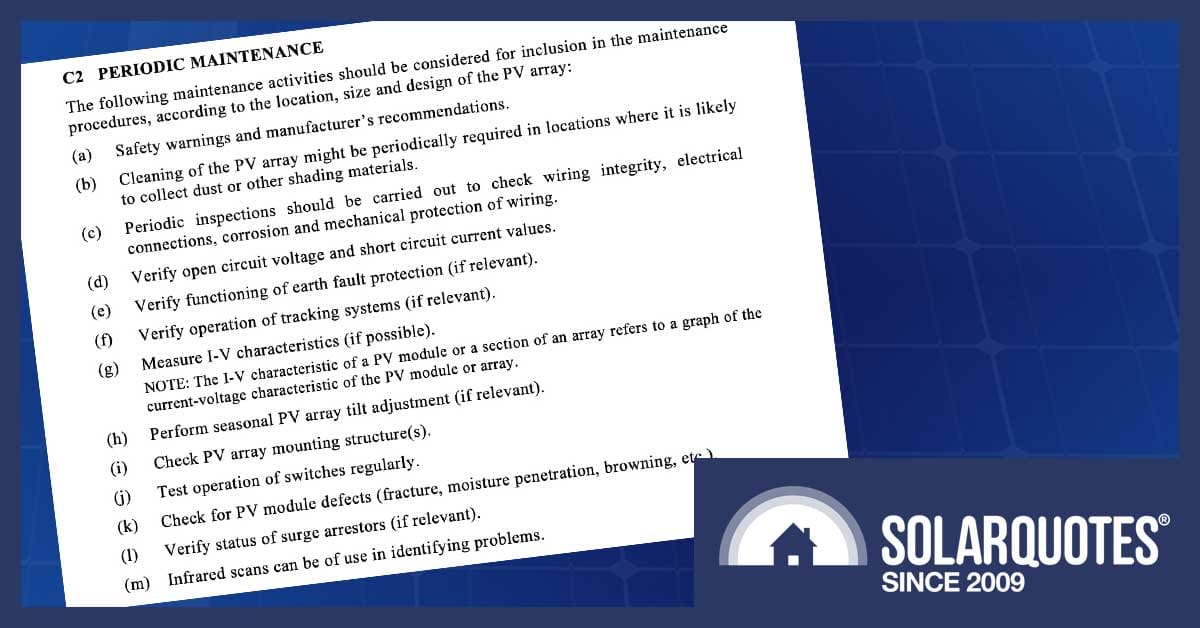
Excerpt from AS5033, the solar array standard.
As part of an ongoing series, I’d like to touch on some important points for maintaining solar.
I’ve worked for all sorts of employers: but in all my years, I think I only ever met one bloke who did truly preventative maintenance — keeping his kit running smoothly, and his employees and customers safe. Please bear with me while I pay tribute…
Greg Harris ran a charter service with coaches and a fleet of school buses. He insisted on teaching his drivers how to change tyres or even suspension parts on the side of the highway because Harris Coaches always got you home.
His phone manner was unique:
“Harris Gawler here! I’m sending you my alternator/starter motor/home rainwater pump.”
“What’s wrong with it Greg?”
“Nothing. Just wants a service. By next week, thanks”
The unit in question would be covered in paint pen; scrawled details of date, cost, and mileage of the last overhaul. Sometimes he’d run out of space to write the successive service histories.
Greg was a joy to work for. Nothing he presented was filthy, seized, or broken. It might need seals and bearings, but in good time, not as a screaming emergency.
The point is, his gear worked perfectly, and he enjoyed trolling the government inspectors who’d try to put his buses off the road for being too old.
When it comes to solar arrays, we could learn a little something from Greg. He kept the show on the road by taking maintenance seriously, and making time for regular inspections.
In solar, that could mean preventing serious safety issues. Here’s how.
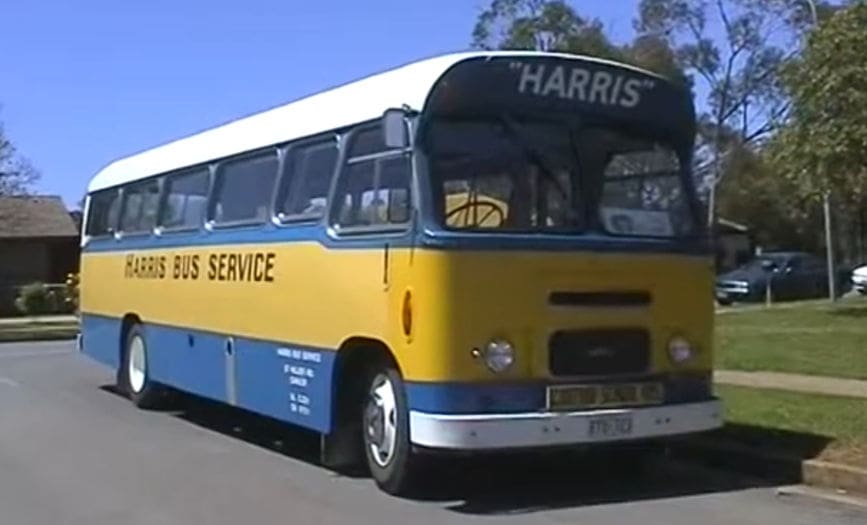
A Harris bus: 40+ years old in this image and still motoring.
Regular Servicing Pays Dividends
As a licensed electrician, I’m obliged to mention that you should have your solar power system inspected and serviced every five years.
However, judging by the comments sections of previous articles, the sceptics will moan that I’m ‘just saying that’, as part of the Confederated Union of Simple Servile Slackers (which, they tell me, is a government-endorsed protectionist racket).
Of course, being CUSSSed for promoting safety and preventing house fires does tend to make your eyes roll.
Beyond that, regular servicing also ensures you’re up to date with regulatory requirements.
What Are Inspectors Looking For Anyway?
From a DNSP1 perspective, the most important part of an inspection is turning the mains off and making sure the inverter shuts itself down.
Inverters must not run as an island, because in the event of an outage or service work, nobody wants your solar power system to electrocute a line worker outside the property.
Keeping An Eye On RTIs
The most troublesome part of any solar power system, by far, is the DC Roof Top Isolator (RTI)2.
Because they start fires.
Once mandated as ‘safety requirement’, RTIs were a stupid idea introduced for spurious reasons (supposedly to isolate solar panels in the event of a fire).
After ten years of incorrect wiring, poor installation and water ingress (which various rule revisions failed to fix), RTIs had caused thousands of needless faults and hundreds of fires. Eventually, these switch disconnect devices were written out of the standards3.
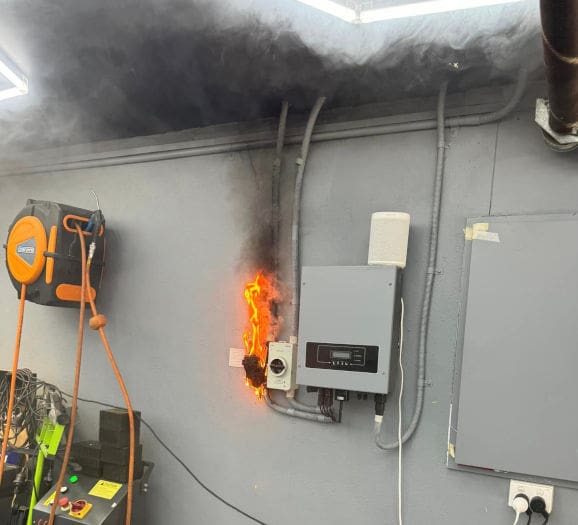
Older systems can also have DC isolators at the inverter, which fill with condensation from the attached conduit.
The main driver for getting rid of them wasn’t the solar industry’s hatred, or electricians’ and inverter makers’ protests (from 19 years ago!) What finally drove the standards committee to delete them was complaints from firefighters themselves.
Those RTIs that remain are the weakest link. They need careful examination and, wherever possible, I suggest removing them.
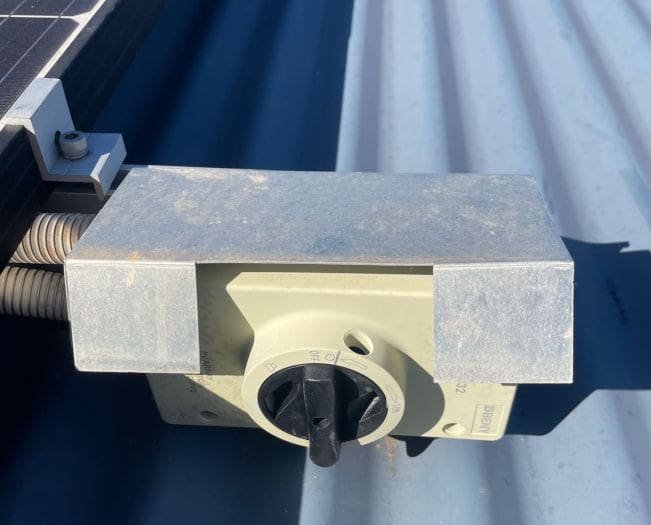
In later years isolators had to have metal shades, not that this example does much.
If you have an RTI, the best way for your electrician to check it, and the panels themselves, is to run a short-circuit test on a sunny day and observe with a thermal camera. Poor connections, blown diodes, broken cells and corroded isolators will show up much more readily, because they run hot.
Bear in mind, just opening the door, or unscrewing the cover of an RTI for a look inside, can compromise it. If the plastic housing is warped, or the gaskets are perished and falling apart, it’ll need to be bogged up with silicone, replaced completely… or better still deleted on general principle.
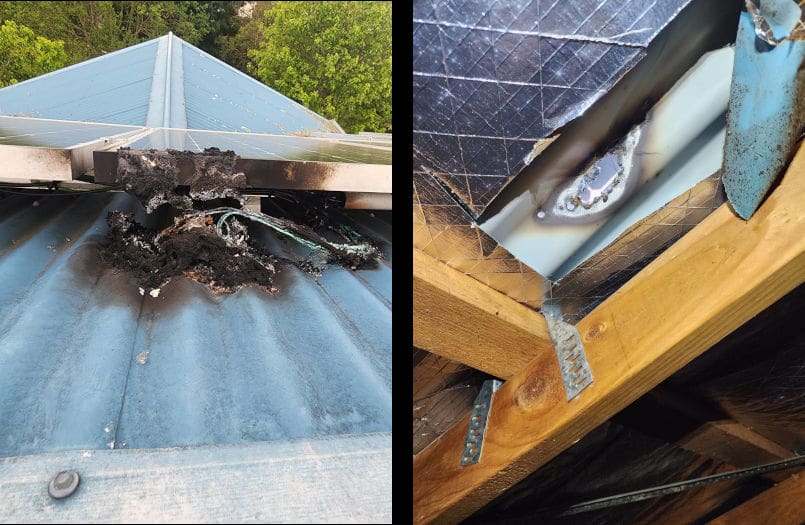
That was an RTI, and yes it has burnt through the roofing iron.
Bogged up with silicone, this was never installed correctly anyway.
A Pragmatic Approach To RTIs
Many electricians will take a common-sense approach and replace the RTI with a simple pair of MC4 plugs and a label, like we used to do 15 years ago. Technically, the rest of the DC wiring needs to be brought up to current standards with new cable, conduit, more labels and specific routing through the roof.
Personally, I would settle for removing the RTI liability and installing an appropriate roof plan in the switchboard.
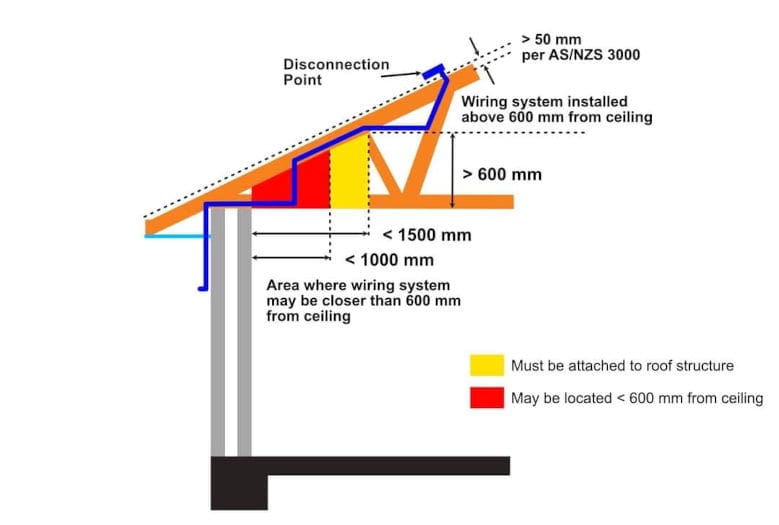
Technically, if you have an RTI replaced with a disconnection point, the DC wiring through the roof must not cross the ceiling. It has to adhere to this diagram.
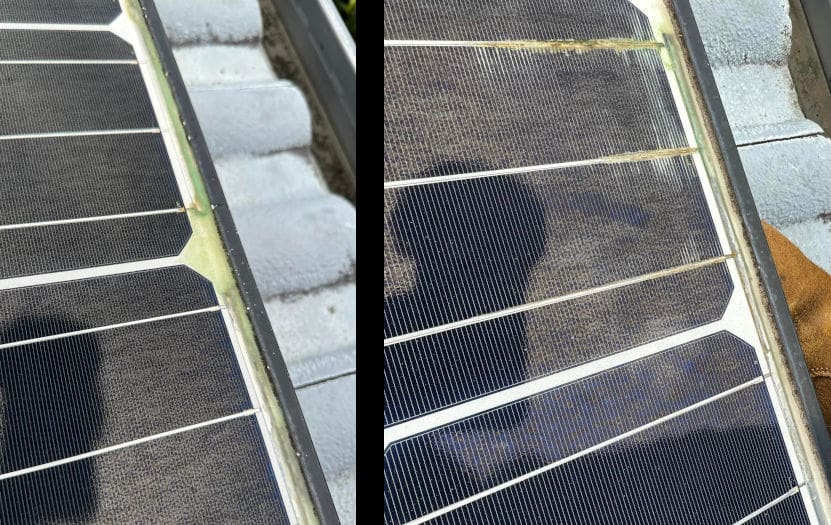
Green under the glass is a sure sign of problems and will usually trip an earth leakage alarm on the inverter.
Earth Fault Alarms
Checking for earth leakage faults should also form part of an inspection, although a one-off formal test with an instrument doesn’t tell you much about how it’s performing over time.
Many people don’t realise an effective earth fault alarm is a legal requirement. So if your monitoring isn’t set up for any reason, advise your installer that you want a service and a savvy technician, who can make the connections work and explain how to interpret the information.
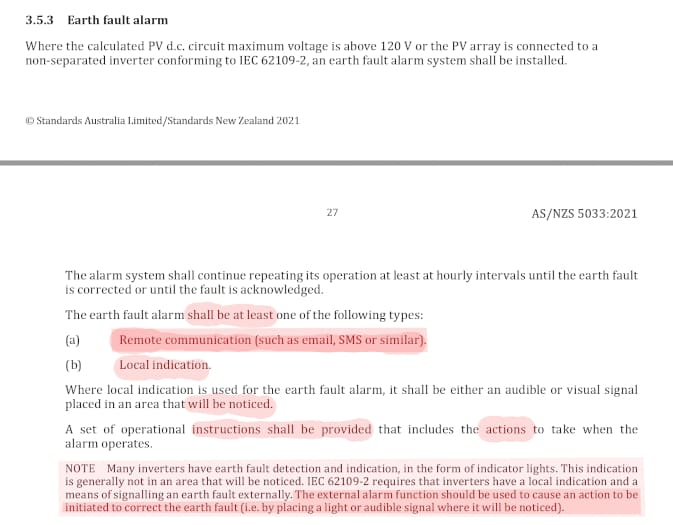
“…will be noticed” is the key phrase here.
Network Rules Oblige You To Have Your System Inspected
When SA Power Networks (SAPN) introduced the small embedded generator agreement, they condensed about nine pages of fine print into two.
The document outlined that if your solar equipment damages their poles or wires, you are obliged to buy SAPN a new electricity network. This blackmail contract also mandates five-yearly inspections by a qualified electrician.
Just because I have never seen the rule enforced doesn’t mean it’s not a good idea, to prevent that kind of damage from coming about. It’s certainly on the books:
Clause 5.5: Your ongoing responsibilities while your small generator remains connected
5.5(c): ensure the small generator is inspected and maintained by an appropriately qualified person:
(i) within at least 5 years after the date of its installation; and
(ii) within at least 5 years after each previous inspect.
It’s Good Sense To Work To Warranty
A good solar company should offer a five-year warranty on the installation works, in my opinion. This ties in with most decent inverters having five-year, 5+5, or ten-year warranties.
Either way, it’s a good idea to have your solar inspected before your warranty runs out, to ensure you can claim for any issues while it’s still valid.
Help Yourself With Basic Hygiene
Keeping things clean and tidy will ensure you don’t cause more problems for yourself between inspections, and will boost your chances of passing with flying colours.
But, statistically speaking, blokes in their 60s don’t bounce, so I don’t highly recommend climbing on the roof yourself. A handyperson who cleans gutters can also clean under arrays and check for dangling wires.
With a hose and a broom, they can clean the panels too. Just make sure nobody walks on the glass.
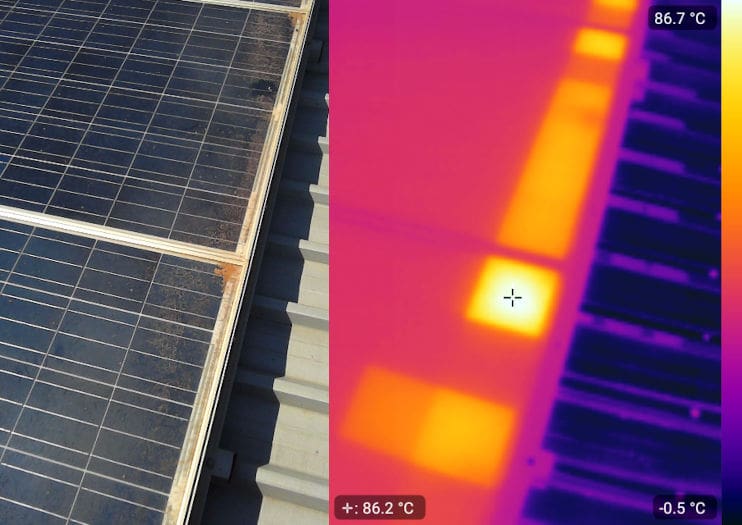
Dirt produces heat when soiled cells are shaded.
Monitor The Situation
I have an old mate who has kept a handwritten logbook tracking his solar yield for more than 12 years now. If we can ever get him to type it into a spreadsheet, he’ll have a brilliant view of the system’s performance over time.
These days, there’s a much better app for that. If your solar system doesn’t have one then I recommend a Catchpower Relay, or try Solar Analytics to measure what’s going on, and to access the tools to optimise your behaviour. A service such as Bill Hero4 can also be really helpful, in terms of selecting an energy retailer.
Monitoring might even expose a drop in performance that can be claimed under a panel warranty.
Equally, a big dump of hail can ruin an array without breaking the glass, so a sudden drop in performance can mean an insurance claim for storm damage.
Regular Inspections Prevent Future Pain
I know arranging regular inspections can feel like the nanny state gone mad, especially when all inspectors seem to do is remove a few leaves, tick a few boxes and walk away.
But inspections can also uncover small problems before they become big problems, saving you a headache (and a hefty bill from your energy retailer) in the future.
If you only consider the damage a faulty RTI can do, the maintenance required to keep tabs on it — and remove it if and when necessary — is easily worth it.
Call me an agent of the nanny state if you must, just remember that an inspection will cost less than the excess on your insurance.

 RSS - Posts
RSS - Posts



I live in Victoria and have Enphase micro inverters and also have RTI’s on the roof. Assuming they have similar reliability issues and apart from the safety inspection should/could they be removed/replaced?
Hi Peter,
The switch mechanisms inside the box are the same for things like air conditioners, so the AC isolators that are required for Enphase aren’t as problematic as the DC isolators or circuit breakers used for solar.
DC is fundamentally much harder to switch, as when you open contacts under load they can arc. With AC as there’s a zero point 50 times per second which extinguishes an arc.
Plus String systems often operate at higher voltage.
Make sure your AC isolators are properly protected from the weather and you’ll have no issues.
Tell old mate that last week my wife WASHED my small spiral notebook with my monthly production from my 4 x 2kw string inverters going back to 2010
But i have them in a spreadsheet so all is not lost.
I remember debating with Finn about the small differences in output of parallel (unshaded) strings on my factory roof and deciding it was all within specification tolerances when I installed them.
I put 4 din Kwh meters in with the install -now 14 years latter there is a delta of over 2000kwh between top preforming and bottom preforming strings.
Several times over the years a zero monthly production has alerted me another inverter had failed!
I use enphase monitoring for overall production and consumption graphing.
Steve Ward
As driver of this bus I’ll take this opportunity to tap the sign at the top of the comments section
1. Real names are preferred – you should be happy to put your name to your comments.
2. Put down your weapons.
3. Assume positive intention.
4. If you are in the solar industry – try to get to the truth, not the sale.
5. Please stay on topic.
It’s funny Anthony, in a recent article you swore black and blue that nobody less than a highly trained, experienced and licensed electrician could ever possibly change a light switch without burning their house down and killing their entire family, despite being presented with clear proof from other countries of that being completely false.
Yet in this article you talk about those same highly trained and licensed experts being totally unable to follow the set standards despite multiple revisions to make it easier for them, and them performing faulty work leading to *thousands* of incidents of fires and system damage. And then you go on to proclaim the rules themselves to also be flawed and in need of revision.
It’s almost like you’re just making it up as you go along to suit your agenda Anthony?
Perhaps it is possible for those poor stupid, unwashed ordinary people to do something as monumentally difficult as change a light switch after all?
Then all those highly skilled tradespeople, of which there is a desperate shortage, instead of charging $250 to change that switch can be freed up to work on the 80% of electrical work around the home that nobody wants home owners to doing themselves.
Hi Liam,
Glad you’re finding the content as entertaining to read as I do writing it.
Actually the revisions of standards were designed to remove errors, like moving to non-polarised circuit breakers made installs simpler. However all the other measures around RTIs, metal shades, vent valves, multi hole glands just made it more difficult to meet the letter of the law. The changes were a band aid to fix a fundamentally bad idea. Removing RTIs is a rare win for those who lament the rise of the nanny state.
Clause 5.5 uses curious wording to insist that inspection or maintenance is low priority:
“(i) within at least 5 years after the date of its installation; and
(ii) within at least 5 years after each previous inspect.”
As 20 years is not less than 5 years, an inspection then unequivocally complies with the stated requirement, which equally makes it impossible to fit both into one decade, as one period would be less than 5 years.
Is there any chance that “at most 5 years” is the intention?
It looks like the same illogic as “I cannot understate the importance of …”, when the importance is in fact not zero, but the intent is to convey that the importance cannot be overstated, because it is so great.
Easier to just take the words “at least” out of the statement.
It then becomes “within 5 years…”.
Of course, if you are being paid per word, you could pad it out to say “within no more than 5 years…”.
Can’t deal with “understate” though.
Do Solar Quotes maintain lists of known-good solar servicing or inspection companies? Our system was installed in late 2018 I think (would need to look this up) and therefore due for a service.
Also, we have a flat roof and I’ll again have to check if the thickness (distance from tin to ceiling) is more or less than 600mm. I hope this doesn’t inject a bunch of issues or retrofits.
I’d also love to read a “Solar Monitoring for Dummies”, because right now we have nothing and I’d love to work out what can or cannot be done with the technology we have)
Thanks.
Hi Michael,
Jump onto the website and you can select “repairs” and add some details at the end.
Or try plugging your postcode in to find a local installer and check out their reviews.
https://www.solarquotes.com.au/installers/cities/
My 8 ear old system has an RTI on the roof without any protection.
Can I request it be removed and if it is, what other work is required?
Hi Dave,
You can have the RTI removed but from a strict interpretation of the rules the DC wiring may have to be replaced & conduit rerouted. The changes to AS5033 also included different cable spec, clearances from the ceiling & a map in the meter box. All that labour & expense may go a long way to a whole new system?
Pragmatic electricians will simply remove the RTI, replace it with MC4 plugs/labels and make sure everything else is safe.